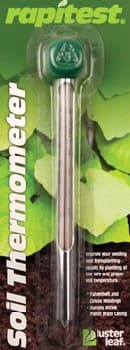- Joined
- Feb 2, 2014
- Messages
- 11,484
- Reaction score
- 5,590
- Location
- La Porte Texas
- Hardiness Zone
- 8b
- Country

I know everyone is getting antsy about spring planting, getting their seeds started as early as possible and when there is no more chance of a frost, getting all those seedlings into the ground ASAP. Well, getting them into the ground ASAP is a mistake many of you will make as you forgot about the second most important thing, soil temperature. On many vegetables such as tomatoes, peppers, eggplant, melons, okra etc. if you plant before the soil is warm enough at 3 inches deep, your seedlings won't die but their growth is either stopped or slowed greatly. They will still produce albeit to a lessor extent so why plant before the correct time? A plant planted later at the correct soil temperature will catch up and surpass a plant planted in the wrong soil temperature. A soil thermometer is a necessary tool and they are cheap and will last forever. The following link is the best one I have found that has a chart.

 www.gardenersnet.com
www.gardenersnet.com

Gardening Soil Temperatures
Seed Germination Soil Temperatures. Identify the ideal soil temperature for seed germination. It varies by plant. Grow with The Gardener's Net

